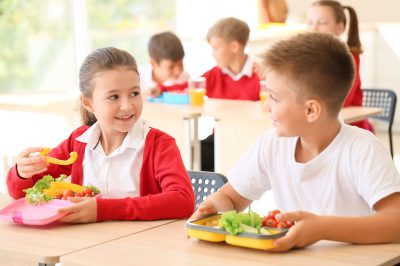Is lunch duty a dreaded task for your school’s staff? Do you yearn for a calmer school lunchtime experience?
Lunchtime is an important part of the school day; pupils have the chance to unwind and refuel in preparation for their afternoon lessons. However, experience shows that the cafeteria can easily become noisy and chaotic, and therefore, not conducive to a refreshing break for pupils or staff!
What can schools do to improve behaviour at lunchtime, and make the lunch hall a more positive, calm environment, so that children return to the classroom ready to learn?
1. Take a united approach to school lunches
Leaving it to a few unlucky team members to keep a handle on a bustling cafeteria full of excited students is a recipe for disaster. While it may be tempting to hide out in the staff room or catch up on marking, schools will see the advantage of staff joining pupils for lunch, instead. Staff benefit from a proper break from work, and with a greater adult presence, lunchtime becomes a continuation of the school day, rather than a free-for-all. This makes the dinner hall a calmer environment.
By having children and adults sit together to share a meal, you also provide a natural opportunity for role modelling. This helps pupils develop their soft skills and improves rapport between children and teachers. With a positive adult influence, children are more focused on eating, resulting in better nutrition for pupils and less food waste for the school kitchen.
Look at your behaviour policies to ensure lunchtime is covered consistently. Of course, you would expect more talking in the cafeteria than the classroom. However, when behaviour interventions are necessary, there should be a whole-school approach. Has the school leadership team trained all staff in how to manage incidents, including caterers, office staff and teaching assistants? If you share responsibility for behaviour and apply rules consistently, pupils know where they stand and are less tempted to push boundaries. Hopefully, calm school lunchtimes will prevail.
2. A social dining experience
Do they behave like this at home? Probably not. Children come to expect a different experience at school vs their own dinner table, and behaviour may quickly decline. Schools can learn from this and restructure lunchtimes to improve behaviour.
Example: Neyland Community School in Wales successfully trialled a new initiative, modelling their lunch services after family-style dinners. The school swapped traditional benches for round tables to foster better communication. They also replaced plastic trays with real tableware, and got pupils to set the table and serve their own sides, from shared dishes. With their own role to play in creating a fun social dining experience, pupils were more invested in the activity. As a result, they began to enjoy more calm school lunchtimes.
3. Pre-ordering streamlines lunch service
Children who haven’t yet sat down to eat also influence the dinner hall atmosphere. Pupils waiting in the lunch queue may become disruptive because they are bored – and ‘hangry’! (Who can blame them?)
However, schools can easily reduce queuing times by enabling pupils or their parents to order meals in advance. Pre-ordering removes the problem of indecisive pupils slowing down lunch service. It also helps catering staff to prepare the right amount of each dish. The kitchen can avoid disappointing children by running out of their favourite meals, plus they can greatly reduce food waste.
Empowering pupils to make their own healthy meal choices can also make lunch a more positive experience. But how can you let students choose for themselves while ordering in advance? Our Classroom Edition module lets pupils choose their lunches in class. The teacher can enter meal choices during registration, or pupils can make their own selection using an interactive whiteboard.

4. Food for thought
Did you know, some nutrients can have a particular effect on children’s concentration levels? Pay special attention to certain ingredients to encourage calm school lunchtimes and better prepare students for their afternoon’s classes:
- Low-GI wholegrains including barley, wild rice, buckwheat, bulgar, oats, quinoa and rye can help keep blood sugar levels steady.
- Omega-3 fatty acids, found in oily fish like mackerel and salmon, plus walnuts, linseeds and flaxseeds, can improve children’s concentration, behaviour and learning abilities.
- Iron and zinc are both linked to behaviour and development. Improving the iron and zinc levels of children with ADHD reduces hyperactivity, impulsivity and impaired socialization. High-iron foods include red kidney beans, chickpeas, nuts, liver and red meat. Meanwhile chickpeas, lentils, beans, sesame seeds, fish and red meat are good sources of zinc.
- Be cautious of E-numbers; some have been linked to hyperactivity in children. These include tartrazine (E102), quinoline yellow (E104), sunset yellow (E110), carmosine (E122), ponceau 4R (E124), allura red (E129) and sodium benzoate (E211)
5. Avoid dinner money mischief: go cashless
Bringing cash into school only complicates matters. It creates avoidable problems between pupils, namely theft and bullying. Money intended to pay for a pupil’s lunch can be lost, stolen, spent on the way to school or traded in the playground. If not handled carefully, this can lead to confusion and embarrassment in the dining hall. Schools must provide a meal and then chase parents after pupils have incurred a debt. Plus, observant children can work out who receives Free School Meals, which may lead to pupils being ostracised.
Providing parents with an easy, secure online payment system for school lunches bypasses the risks associated with handling cash on-site. Payments are secure and easily tracked, while administrators simply allocate Free School Meal funding to the appropriate accounts, ensuring pupils’ anonymity. You can also encourage parents to keep a positive balance, by making this a requirement for online ordering. This reduces the need to chase debt later.


